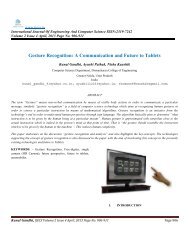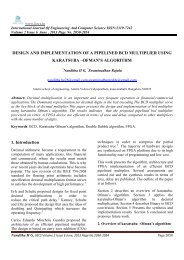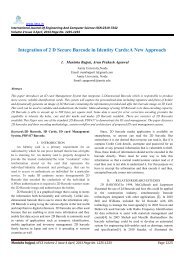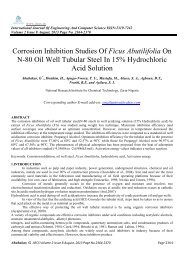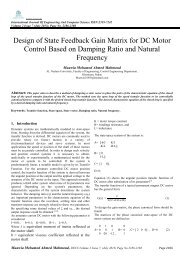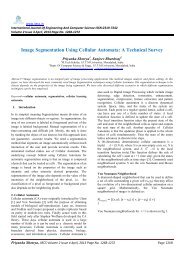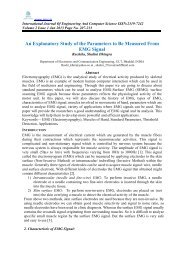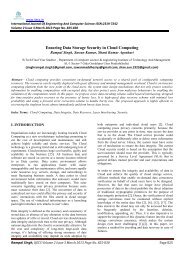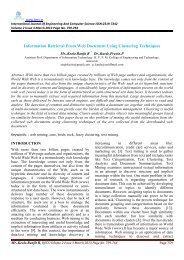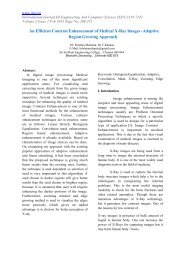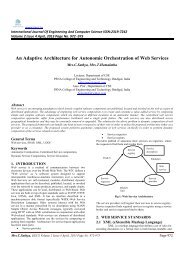Numerical Integration Over Polygonal Domains using Convex ... - Ijecs
Numerical Integration Over Polygonal Domains using Convex ... - Ijecs
Numerical Integration Over Polygonal Domains using Convex ... - Ijecs
Create successful ePaper yourself
Turn your PDF publications into a flip-book with our unique Google optimized e-Paper software.
x<br />
y<br />
x<br />
y<br />
x<br />
y<br />
(1)<br />
(1)<br />
(2)<br />
(2)<br />
(3)<br />
(3)<br />
( , )<br />
<br />
( , )<br />
<br />
( , )<br />
<br />
( , )<br />
<br />
( , )<br />
<br />
( , )<br />
<br />
1<br />
x<br />
p<br />
xq<br />
xr<br />
1<br />
y<br />
p<br />
yq<br />
yr<br />
1<br />
xq<br />
xr<br />
x<br />
p<br />
1<br />
yq<br />
yr<br />
y<br />
p<br />
1<br />
xr<br />
x<br />
p<br />
xq<br />
1<br />
yr<br />
y<br />
p<br />
yq<br />
with ( , )<br />
, (<br />
, )<br />
as given in eqns. (19) and (24).<br />
(26)<br />
(27)<br />
(28)<br />
6 <strong>Numerical</strong> <strong>Integration</strong> Formulas<br />
6.1 <strong>Numerical</strong> integration over an Arbitrary Triangle PQR<br />
We could use either of the formulas in eqn.(16) or eqns.(26-28). We prefer to use eqn.(25), since it requires<br />
(1) (1)<br />
the computation of just one set of ( u,<br />
v)<br />
( u , v ) for all the three quadrilaterals. The transformation<br />
formulas of eqns. (26-28) are easy to implement as a computer code, since the coordinates of PQR<br />
are to<br />
( e)<br />
( e)<br />
(1) (1)<br />
be used in cyclic permutation in ( x , y ), e 1,2,3)<br />
. Note that in ( x , y )<br />
T<br />
T<br />
T<br />
( x<br />
p,<br />
y<br />
p<br />
) , ( xq,<br />
yq<br />
) , ( xr<br />
, yr<br />
) respectively. In<br />
T<br />
T<br />
T<br />
( x<br />
q,<br />
yq<br />
) , ( xr<br />
, yr<br />
) , ( xp,<br />
y<br />
p<br />
) respectively and in<br />
(2) (2)<br />
( x , y )<br />
(3) (3)<br />
( x , y )<br />
H. T. Rathod a IJECS Volume 2 Issue 8 August, 2013 Page No.2576-2610 Page 2582<br />
T<br />
T<br />
T<br />
the coefficients of w , u,<br />
v are<br />
the coefficients of w , u,<br />
v are<br />
the coefficients of w , u,<br />
v are<br />
T<br />
T<br />
T<br />
( x<br />
r<br />
, yr<br />
) , ( x<br />
p,<br />
y<br />
p<br />
) , ( xq,<br />
yq<br />
) respectively. We can use Gauss Legendre quadrature rule to evaluate eqn.(25).<br />
The resulting numerical integration formula can be written as<br />
PQR<br />
NN<br />
<br />
3<br />
( e)<br />
( N ) ( N ) ( e)<br />
( N ) ( N )<br />
f ( x ( U<br />
k<br />
, Vk<br />
), y ( U<br />
k<br />
, Vk<br />
)) <br />
( N )<br />
I I ( f ) 2<br />
W<br />
(29)<br />
pqr<br />
k 1<br />
k<br />
e1<br />
The weights and sampling points in the above formula satisfy the relation<br />
N)<br />
( N)<br />
( N)<br />
( N)<br />
( N)<br />
( N)<br />
( N)<br />
( N)<br />
( N)<br />
( N)<br />
( W , U , V ) (4 s s ) w w 96, u(<br />
s , s ), v(<br />
s , s<br />
( ( N)<br />
) <br />
k<br />
k<br />
k<br />
i<br />
j<br />
i<br />
j<br />
k 1 ,2,3,......<br />
N N , i , j 1,2,3 ,...... N<br />
(30)<br />
and<br />
( N)<br />
( N)<br />
( N)<br />
( N)<br />
( N)<br />
( N)<br />
u(<br />
s , s ) (1 s )(1 s ) 12 (1 s )(1 s ) 8,<br />
i<br />
j<br />
i<br />
j<br />
i<br />
j<br />
( N)<br />
( N)<br />
( N)<br />
( N)<br />
( N)<br />
( N)<br />
v(<br />
si<br />
, s<br />
j<br />
) (1 si<br />
)(1 s<br />
j<br />
) 12 (1 si<br />
)(1 s<br />
j<br />
) 8<br />
(31)<br />
( N ) ( N )<br />
for a N- point Gauss Legendre rule of order N with (<br />
wn , sn<br />
), n 1, 2,3,......<br />
N as the weights and<br />
sampling points respectively.<br />
( N ) ( N ) ( N )<br />
2<br />
We can compute the arrays ( Wk , U<br />
k<br />
, Vk<br />
), k 1, 2,3,...... N for any available Gauss Legendre<br />
quadrature rule of order N. We have listed a code to compute the arrays<br />
( N ) ( N ) ( N )<br />
2<br />
( Wk , U<br />
k<br />
, Vk<br />
, k 1, 2,3,...... N ) for N = 5, 10, 15, 20, 25, 30, 35, 40. This is necessary since explicit list<br />
( N ) ( N ) ( N )<br />
of ( Wk , U<br />
k<br />
, Vk<br />
, N = 5, 10, 15, 20, 25, 30, 35, 40)<br />
will generate a large amount of values, viz: 25, 100,<br />
( N ) ( N ) ( N )<br />
225, 400, 625, 900, 1225, and 1600 for each of W<br />
k<br />
, U<br />
k<br />
, Vk<br />
. The computer code will be simple with<br />
( N ) ( N )<br />
few statements and it requires the input values of (<br />
w , s , n 1,2,..., N),<br />
N 5,10,15, 20,25,30,35,40<br />
6.2 Composite <strong>Integration</strong> over a polygonal Domain P N<br />
<br />
<br />
i<br />
j<br />
i<br />
j<br />
n n<br />
.<br />
We now consider the evaluation of II<br />
<br />
( f ) f ( x,<br />
y)<br />
dxdy , where f C()<br />
and is any polygonal<br />
2<br />
domain in . That is a domain with boundary composed of piecewise straight lines. We then write<br />
M<br />
M<br />
<br />
2<br />
<br />
<br />
<br />
P<br />
( f ) <br />
T<br />
( f ) <br />
<br />
Q<br />
( f )<br />
<br />
(32) in which, we define<br />
N<br />
n<br />
3 n p<br />
n1<br />
n1<br />
p0<br />
<br />
P is a polygonal domain of N oriented edges ( k i 1,<br />
i 1,2,3,..., N),<br />
with end points x , y ), x , y )<br />
N<br />
l ik<br />
(<br />
i i<br />
(<br />
k k



